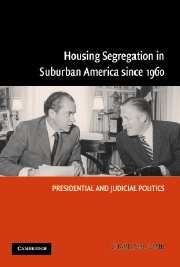Book contents
- Frontmatter
- Contents
- Preface and Acknowledgments
- Abbreviations
- Housing Segregation in Suburban America since 1960
- 1 Separate Worlds, Separate Lives
- 2 Lyndon Johnson and the Fair Housing Act
- 3 George Romney's Blueprint for Suburban Integration
- 4 Richard Nixon, Centralization, and the Policymaking Process
- 5 Suburban Segregation from Gerald Ford to Bill Clinton
- 6 The Federal Courts and Suburban Segregation
- 7 Conclusions
- Appendix
- Bibliography
- Index
2 - Lyndon Johnson and the Fair Housing Act
Published online by Cambridge University Press: 21 November 2009
- Frontmatter
- Contents
- Preface and Acknowledgments
- Abbreviations
- Housing Segregation in Suburban America since 1960
- 1 Separate Worlds, Separate Lives
- 2 Lyndon Johnson and the Fair Housing Act
- 3 George Romney's Blueprint for Suburban Integration
- 4 Richard Nixon, Centralization, and the Policymaking Process
- 5 Suburban Segregation from Gerald Ford to Bill Clinton
- 6 The Federal Courts and Suburban Segregation
- 7 Conclusions
- Appendix
- Bibliography
- Index
Summary
President Lyndon Johnson promised Americans nothing less than a Great Society, and fair housing was part of his vision. Even though John F. Kennedy made a limited attempt to promote fair housing through an executive order, the critical breakthrough emerged during the Great Society. Johnson played an influential role in placing housing discrimination on the national agenda and garnering legislative support for Title VIII of the Civil Rights Act of 1968, more commonly known as the Fair Housing Act. After inheriting the act, Richard Nixon significantly helped to define its meaning and application for decades to come. Johnson made efforts to combat housing segregation through the Fair Housing Act, but Nixon's politics would nourish the segregation that already existed in the suburbs.
HOUSING SEGREGATION IN JOHNSON'S AMERICA
The need for a federal fair housing statute was apparent from the pervasiveness of black-white housing segregation during President Johnson's lifetime. Vast decaying ghettos, so prevalent during Johnson's presidency, were nonexistent before the twentieth century. Following World Wars I and II, housing segregation became pronounced, growing deep roots in northern metropolitan areas after the large-scale migration of African Americans from the South. This so-called Great Migration, occurring between 1910 and 1970, constituted the greatest movement of people in the United States during the twentieth century. It was stimulated not only by repressive political and social conditions in the South but also by unprecedented economic and technological developments in both the North and the South.
- Type
- Chapter
- Information
- Housing Segregation in Suburban America since 1960Presidential and Judicial Politics, pp. 26 - 55Publisher: Cambridge University PressPrint publication year: 2005



